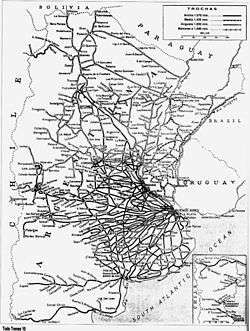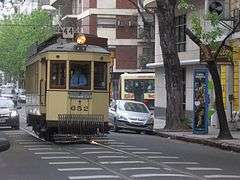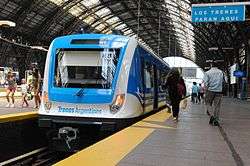Rail transport in Argentina
The Argentine railway network consisted of a 47,000 km (29,204 mi) network at the end of the Second World War and was, in its time, one of the most extensive and prosperous in the world. However, with the increase in highway construction, there followed a sharp decline in railway profitability, leading to the break-up in 1993 of Ferrocarriles Argentinos (FA), the state railroad corporation. During the period following privatisation, private and provincial railway companies were created and resurrected some of the major passenger routes that FA once operated.
| Argentina | |||||||
|---|---|---|---|---|---|---|---|
| Operation | |||||||
| National railway | Ferrocarriles Argentinos | ||||||
| Infrastructure company | ADIFSE | ||||||
| Statistics | |||||||
| Ridership | 367 million[1] | ||||||
| System length | |||||||
| Total | 36,966 km (22,970 mi) (8th)[2] | ||||||
| Track gauge | |||||||
| 5 ft 6 in (1,676 mm) | 26,475 km (16,451 mi) | ||||||
| 1,435 mm (4 ft 8 1⁄2 in) | 2,780 km (1,730 mi) | ||||||
| 1,000 mm (3 ft 3 3⁄8 in) | 7,711 km (4,791 mi) | ||||||
| Secondary narrow gauges | 424 km (263 mi) | ||||||
| |||||||
Dissatisfied with the private management of the railways, beginning in 2012 and following the Once Tragedy, the national government started to re-nationalise some of the private operators and ceased to renew their contracts. At the same time, Operadora Ferroviaria Sociedad del Estado (SOFSE) was formed to manage the lines which were gradually taken over by the government in this period and Argentina's railways began receiving far greater investment than in previous decades.[3][4][5] In 2014, the government also began replacing the long distance rolling stock and rails and ultimately put forward a proposal in 2015 which revived Ferrocarriles Argentinos as Nuevos Ferrocarriles Argentinos later that year.[6][7][8][9]
The railroad network today, with its 36,966 km (22,970 mi) size, is now somewhat smaller than it once was, though still the 8th largest in the world.[2]
History
.jpg)
The growth and decline of the Argentine railways are tied heavily with the history of the country as a whole, reflecting its economic and political situation at numerous points in history, reaching its high point when Argentina ranked among the 10 richest economies in the world (measured in GDP per capita) during the country's Belle Époque and subsequently deteriorating along with the hopes of the prosperity it came so close to achieving.[10]
In the early years, the railway was emblematic of the vast waves of European Immigration into the country, with many coming to work on and operate the railways, such as the Italian-Argentine Alfonso Covassi, the country's first engine driver,[11] and also in the sense that the population boom experienced as a result of this immigration required means of transportation to meet growing demands. Much like in the American West, the railways also played a key role in the creation and expansion of new population centres and boomtowns in remote parts of the country.[12]
Development
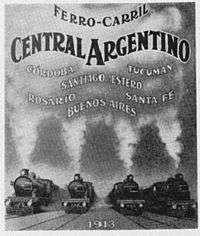

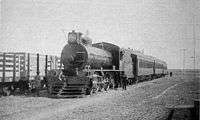
The importance of foreign capital in the construction of the Argentine railways is perhaps overstated,[13] with initial construction of the network beginning in 1855 at first with Argentine finance, which continued throughout the network's development.[14] The Buenos Aires Western, Great Western and Great Southern railways (today the part of the San Martín, Sarmiento and Roca railways respectively) were all commenced using Argentine capital with the Buenos Aires Western Railway being the first to open its doors in the country, along with its Del Parque railway station.[15]
Following the adoption of liberal economic policies by president Bartolomé Mitre, these railways were sold off to foreign private interests, consisting of mostly British companies, in what would be the first of many acts where the ideological climate of the time would define the fate of the Argentine railways.[16] These sales also included Argentina's first railway, the Buenos Aires Western (by now 1,014 km long), which was sold in 1890 to the British company New Western Railway of Buenos Aires for just over 8.1 million pounds (close to £500 million in 2005 money[17]).[18] This sale, and others that came after it, was heavily criticised at the time for being far lower than the actual value of the railway, and prompted many anti-British protests.[13] In later years, this was also criticised by historians:
During the 27 years in which it belonged to the Government of the Province of Buenos Aires, the Western Railway was the line which was most luxurious, least wasteful [...] and offered the most economical fares and cargo rates. It was a model company which was the pride of Argentina, in relation to which all the English railway companies established in our country were, without exception, second-rate…[But after the sale] the unnecessary growth in spending, largely due to the disproportionate increase in employees, the resulting decrease in returns and the rise in ticket prices made up a definite intent to sabotage: the Western Railway would quickly be discredited in the public opinion.
In the years that followed, there were numerous cases of undervalued sales to British investors, including the 1,000 km (620 mi) long Andean Railway, which provoked much anti-British sentiment in the country.[20] By 1910 the network had been monopolised by British companies, owned by large finance firms such as J.S. Morgan & Co. in London.[20] Nevertheless, major development of the Argentine rail network occurred up to this period and the Argentine state also played a large role, financing ferrocarriles de fomento (development railways) in rural areas not attractive to private interests,[11] while the Argentine State Railway had a 9,690 km (6,020 mi) network.[21]
By 1914, the Argentine rail network attained significant growth having added 30,000 km (19,000 mi) to the network between 1895 and 1914,[22] which positioned the country as having the tenth largest rail network in the world in that year, at a point where the country had the tenth highest per-capita GDP in the world.[23] Its expansion accelerated greatly due to the need for the transport of agricultural products and cattle in Buenos Aires Province. The rail network converged on the city of Buenos Aires and was a key component in the development of the Argentine economy as it rose to be a leading export country. However, with the advent of the First World War, then subsequently the Wall Street Crash and Great Depression, the rail network of the country experienced a much lower rate of growth after this period and had mostly ground to a halt by the beginning of the Second World War.[24][25]
| Years | 1860 | 1870 | 1880 | 1890 | 1900 | 1910 | 1920 |
|---|---|---|---|---|---|---|---|
| System length (kilometres) | 9.8 | 722 | 2,516 | 9,397 | 16,500 | 29,094 | 47,000 |
| Passengers transported (millions) | – | – | 3 | – | 18 | – | 145 |
| Cargo transported (x 1,000,000 tonnes) | – | – | 1.0 | – | 11.8 | – | 45.5 |
.jpg) Exterior of Del Parque station (c.1857-84)
Exterior of Del Parque station (c.1857-84) Railway strike on the Buenos Aires Northern Railway, the first British railway in Argentina (c.1904)
Railway strike on the Buenos Aires Northern Railway, the first British railway in Argentina (c.1904) Buenos Aires and Pacific Railway train in Palermo (c.1930)
Buenos Aires and Pacific Railway train in Palermo (c.1930).jpg) Comodoro Rivadavia Railway train in Patagonia (c.1940)
Comodoro Rivadavia Railway train in Patagonia (c.1940)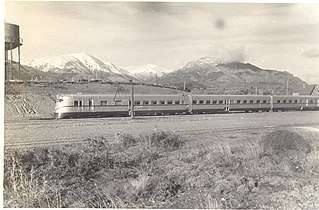 A Ferrocarriles Patagónicos Ganz DMU in Chubut province (1945)
A Ferrocarriles Patagónicos Ganz DMU in Chubut province (1945)
Nationalisation
By the end of the Second World War, the United Kingdom owed Argentina m$n 2 billion after the country had filled the gaps in food shortages during the war effort.[27][28] Following what was then a worldwide trend, the private companies were nationalised by the government of Juan Perón, beginning in 1946 with the French railways and then purchasing the British railways after an agreement was signed cancelling the British debt in 1947.[29][30] Perón later claimed in an interview that the British envoys had offered him a bribe of US$100 million if the state paid an extra m$n 6 billion for the railways on top of the debt cancellation.[27]
Ferrocarriles Argentinos divisions
After the 1948 nationalisation, the 47,000 km (29,000 mi) long Argentine railway network was separated into six divisions managed by State-owned company Ferrocarriles Argentinos. Of the 20 railways incorporated into Ferrocarriles Argentinos, 7 were Argentine, 10 were British and 3 were French prior to nationalisation. There were grouped together by track gauge and location and named after important figures in Argentine History. Maps of those division companies were as follows:
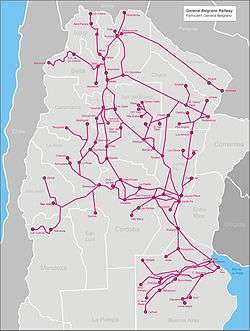 Belgrano
Belgrano
1,000 mm (3 ft 3 3⁄8 in)
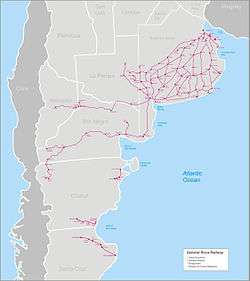



Soon after the reorganisation, Perón turned it into a political matter with the nationalisation becoming a symbol of national autonomy and independence from foreign powers rather than an administrative change and is still to this day regarded by justicialists as a move against neo-imperialsm.[31][32] Although for many years the state-owned railways were able to provide a good standard of passenger and freight service, over the years the changing politics of Argentina began to take its toll. By the 1960s, the post-war economic boom had ushered in a new age of the automobile, with rail transport on its way out around the world, a trend from which Argentina was not left unscathed.[22]
Following the ousting of Perón from power, the Larkin Plan was implemented to modernise transport in the country with backing from the World Bank and intended to make investments in the country's railways.[33] However, by 1961 its aims had changed significantly and the plan had evolved into one which prioritised automobile transportation and began lifting sections of railway - an act which was put to an end following a series of strikes by railway workers in opposition to the plan.[34] Later governments between 1967 and 1971 then continued investing in the railways and enacted modernisation plans, renewing much of the rolling stock and the railways continued to function well.[35]
Under the military junta, the 1970s and 1980s saw a significant decline in Argentina's railways. In 1965, 25% of cargo and 18% of passengers were transported by rail, while by 1980 this figure had dropped to 8% and 7% respectively and Ferrocarriles Argentinos was losing US$1 million per day maintaining an ageing system with dwindling passenger numbers.[36] Between 1976 and 1980, 560 stations were closed, along with 5,500 km (3,400 mi) of track, while the number of employees in railway workshops alone fell from 155,000 to 97,000.[37]
By the time the country returned to democratic rule, the railways were in bad shape and the country was overwhelmed by the economic burdens and debts left over from the junta.[38] Under this context, and with the state unable to cope with the cost of managing the railways due to a large fiscal deficit, the privatisation of the network came into consideration.
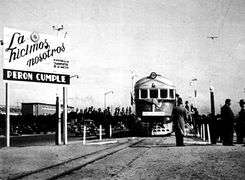 Argentine locomotive "La Justicialista" being inaugurated (1952)
Argentine locomotive "La Justicialista" being inaugurated (1952)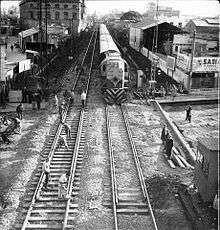 Railway workers on the San Martín Line (1969)
Railway workers on the San Martín Line (1969)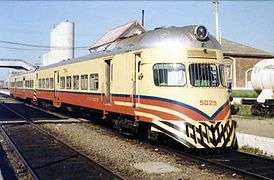 Fiat Materfer 7131 units were emblematic of the 1960s
Fiat Materfer 7131 units were emblematic of the 1960s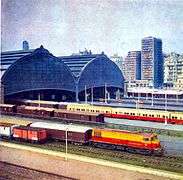 Ferrocarriles Argentinos rolling stock outside Retiro Mitre station (1968)
Ferrocarriles Argentinos rolling stock outside Retiro Mitre station (1968)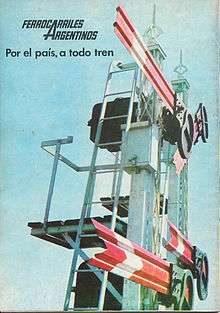 Ferrocarriles Argentinos poster from the 1970s
Ferrocarriles Argentinos poster from the 1970s Ferrocarriles Argentinos train on the Urquiza Railway (1990)
Ferrocarriles Argentinos train on the Urquiza Railway (1990)
Privatisation

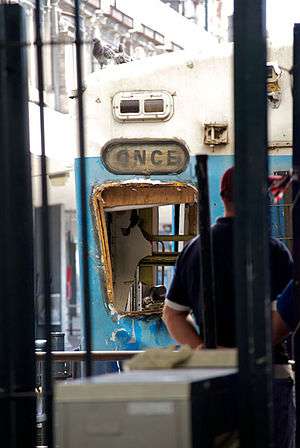
Under the presidency of Carlos Menem, Argentina radically changed its economic policies moving from a more Import substitution industrialisation-orientated model towards neoliberal shock therapy and the Washington Consensus under the supervision of the International Monetary Fund.[39][40] Much like under the classical liberalism of the late 19th and early 20th century, under these plans, Argentina would sell off most of its state assets at extremely reduced prices, among them the railways.[35][41]
During these reforms, between 1992 and 1995, the government decided break up and to privatise the state-owned company Ferrocarriles Argentinos (FA), which comprised six relatively independent divisions, Sarmiento, Mitre, Urquiza, San Martín, Belgrano and Roca, and granted concessions to private companies for their operation through competitive bidding, while doing the same with freight services.[42]
At the start of the concessions, the railway network was quickly reduced to one quarter of its capacity, with long distance lines disappearing almost completely.[22][43] At the same time, as more locomotives and rolling stock were needed, the private companies became increasingly reluctant to make the investment required to increase capacity and thus service quality and passenger numbers declined.[22] Railway privatisation resulted in the loss of some 70,000 jobs in the railway sector over the years, whilst by 1998 some 793 railway stations had been closed.[44] In addition, companies operating other transport means (such as bus transport) who had vested interests seeking the demise of the railway, purchased lines for far less than their real value.[45]
Under privatisation, substantial government subsidies continued in order to keep the system from collapsing, the state continued losing money on the railways.[43] During this period, the railways were plagued by negligence, while private operators persistently ignored warnings from inspectors whilst failing in their contractual obligations to maintain railway infrastructure.[43] Similarly, over the years, government subsidies to the private companies increased to levels similar to the losses incurred under the state management of the railways, albeit now with a much more limited service and further deteriorated infrastructure.[45]
The closing of much of the rail system also led to the emptying of many rural towns dependent on the railways, creating ghost towns and therefore to a dismantling of the development that had taken place there since the arrival of trains.[46] Argentine agriculture found itself in the difficult position of shipping its goods less efficiently using road transport, which costs around 72% more than state-owned rail services.[47]
The economic crisis in 2001 was the final blow and neither the private companies nor the government could provide the service required. In 2003, the new administration of President Néstor Kirchner set it as a key policy objective to revive the national rail network. Although the economic upturn saw traffic grow again, the suburban rail operators were still little more than managers of government contracts rather than true entrepreneurs.[48]
Re-nationalisation
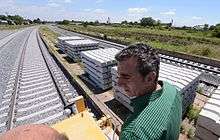
In 2008, the National Government formed Trenes Argentinos Operadora Ferroviaria (SOFSE) to manage some freight and passenger lines in the country.[3] The Once Tragedy of February 2012 prompted further action by the government, resulting in the revocation of the Sarmiento Line and Mitre Line concessions from Trenes de Buenos Aires (TBA) in May of that year, with both lines eventually being put under the management of the state-owned SOFSE.[49][50] In June 2012, the government announced that it was renationalising some freight railways citing "serious breaches of contract" by the operators, this culminated in the nationalisation of the Belgrano Cargas network which operates on over 10,000 km (6,200 mi) of metre gauge track.[51][52]
This trend continued in the following years and the government began re-opening services and improving on the once private services using completely new rolling stock, including long distance services like the one from Buenos Aires to Mar del Plata and Buenos Aires-Rosario-Cordoba.[53][54] This new-found investment in the railways has not been limited to rolling stock since, in many cases, the state has completely replaced, or is in the process of replacing, the existing infrastructure with continuous welded rails on concrete sleepers and undertaking other works such as renovating level crossings and building new railway bridges.[55][56][57] The freight network has also received significant investment from China, with two investments totalling US$4.8 billion made in 2013 and 2015.[58]
While from 2008 to 2014 there were many indications that the state was re-nationalising parts of the railway and making efforts towards improving it, in 2015 it was announced that complete nationalisation of the remaining lines and services were on the table after a project was put forward that would see the resurrection of Ferrocarriles Argentinos as a state-owned holding company which would incorporate SOFSE (passenger services), TACyL (freight) and ADIFSE (infrastructure).[6] This was put into effect in April 2015 when, by overwhelming majority, the Argentine Senate passed the law which re-created Ferrocarriles Argentinos and effectively re-nationalised the country's railways, a move which saw support from all major political parties across the political spectrum.[7][8][9] Expenditure for the railway network was set at AR$ 9 billion for 2015, while in 2016 it is expected to be AR$7.2 billion.[59]
Commuter rail and trams
Buenos Aires, Mendoza, Cordoba, Resistencia, Paraná, La Plata, Santiago del Estero and Salta are the only cities in Argentina to offer suburban passenger services; most other cities rely on bus and trolleybus transportation, though in the past there were more networks and most major cities had a tramway network.
Buenos Aires
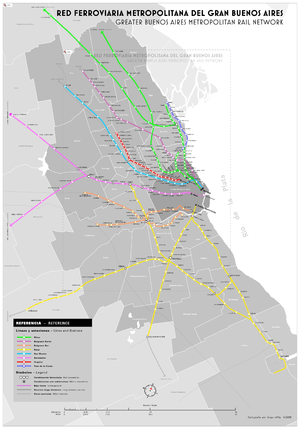
Greater Buenos Aires' metropolitan rail system is the second most extensive in the Americas after New York's commuter rail system, with about 259 stations, covering 900 km (559 mi) and 7 rail lines serving more than 1.4 million commuters daily in the Greater Buenos Aires area.[60][61] Commuter rail services from the suburbs is mostly operated by SOFSE, though some private operators remain. The rail lines converge at five rail terminals, all of them in Buenos Aires, with two, Retiro and Constitución rail terminals being the busiest train stations in Argentina, though there is a plan to connect all the lines in one central underground station for easy transfer.[60]
| Line | Operator | Length (Km) | N° stations | Annual ridership (2014)[61] |
|---|---|---|---|---|
| Mitre | Trenes Argentinos | 185,5 | 55 | 18,330,512 |
| Belgrano Norte | Ferrovías | 54,3 | 22 | 28,876,619 |
| Belgrano Sur | Trenes Argentinos | 66,3 | 30 | 10,974,454 |
| Roca | Trenes Argentinos | 237,2 | 70 | 115,032,946 |
| San Martín | Trenes Argentinos | 56,3 | 19 | 39,239,510 |
| Sarmiento | Trenes Argentinos | 184,1 | 40 | 39,663,847 |
| Urquiza | Metrovías | 29,9 | 23 | 12,585,106 |
| Totals: | 813 | 259 | 264,702,994 | |

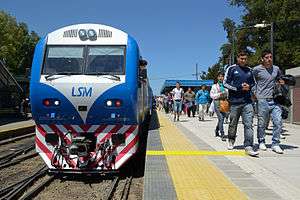
Buenos Aires City's commuter rail provides 1800 trains carrying 1.4 million passengers each business day in the city of Buenos Aires, its suburbs in Greater Buenos Aires and several far-reaching satellite towns.[60] Service is provided by private companies and spreads out from five central stations in Buenos Aires: Retiro, Constitución, Once and Federico Lacroze – all serving both long-distance and local passenger services – and Buenos Aires Station which, despite its name, is a secondary rail terminus serving only local commuter services and will cease to be a terminal once the Belgrano Sur Line is extended to Constitución.[62]
The Retiro and Constitución train stations are linked by Line C of the Buenos Aires Underground, Once is served by Line A of the underground via its "Plaza Miserere" station and by Line H's Once station, while Federico Lacroze is served by Line B.[63] The smaller Buenos Aires Station is accessible by some city bus services and it is the only railway terminus in Buenos Aires that has no access to the Buenos Aires Underground, though it is connected to the Metrobus Sur line.[64]
Most trains leave at regular 8-20 minute intervals, though for trains travelling a longer distance service may be less frequent.[65] Fares are cheap and tickets can be purchased at ticket windows or through the SUBE card machines at stations.[66] Most of the lines are electrictrified, several are diesel-powered, while some of these are currently being electrified and some of the lines share traffic with freight services.
Buenos Aires area commuter rail lines were privatised in the 1990s, and passengers had complained for years about poor commuter rail services on lines leading from Constitución station in downtown Buenos Aires to the capital's southern suburbs.[67] However, in recent years all but two of the services have been re-nationalised and are operated by Trenes Argentinos (SOFSE).[68]
Light rail and trams
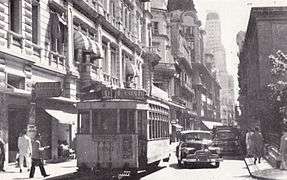
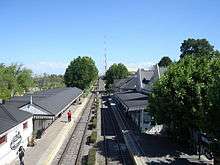
Buenos Aires once had one of the most extensive tramway systems in the world, with a 875 km (544 mi) network in the city proper alone, which gained the city global notoriety as being "The City of Trams" in the late 19th and early 20th century.[69][70] The system remained popular throughout its existence but, despite this, it was dismantled in the mid-1960s in favour of bus transport.[71] Today, some minor tram services remain, as well as light rail services in the city proper and Greater Buenos Aires.
The light rail Tren de la Costa (Train of the Coast), which serves tourists and local commuters, runs from the northern suburbs of Buenos Aires to Tigre along the river for approximately 15 km (9 mi). The line connects directly to the Mitre Line at Maipú–Bartolomé Mitre station in the northern suburb of Olivos for direct access to Retiro terminus in the centre of the city.[72]
An experimental project of a short run tramway line, Tranvía del Este, was inaugurated in 2007 in the Puerto Madero district of Buenos Aires. The 2 km prototype line ran between the Córdoba and Independencia avenues, ridership was not as expected and the line closed in 2012.[73] A Historic Tramway operates on weekends and holidays in the Caballito neighbourhood of the capital with free fares and using vintage rolling stock from the now defunct Buenos Aires tramway network.[74][75]
Another tramway line, the Buenos Aires Premetro, operates as a feeder at the end of Underground Line E, running through some of the city's southern districts.[76] Though there is currently only one Premetro line (E2), originally many other lines were planned to run as feeder services to the Buenos Aires Underground, however due to their planned construction coinciding with the privatisation of the Underground network, these never materialised.[77] The creation of new lines has been proposed as late as 2012, however it is now accepted that, with the creation of the Metrobus network in 2011, the need for further Premetro lines has been made redundant.[78][79]
Ticketing
The Buenos Aires public transit system uses a ticketing system. All tickets are bought at ticket booths and ticket printing consoles at railway stations and on board certain trains. Tickets can be bought either using cash or by using the SUBE card (also used throughout the country for buses, tollbooths and underground).[66] Ticket cost differ depending on the payment method: If the tickets are bought using SUBE, the user can benefit from a government subsidy which translates to a substantially reduced fare.[80] Children under three years of age, children in school uniform, retired people receiving pensions and the disabled do not have to pay to use these services in most cases.[81] Similarly, university students and staff have a 20% discount, with a 50% discount proposed in 2015.[82]
Electrification
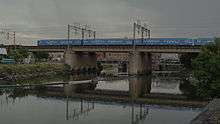
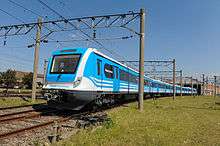
Although the first electric railway between Retiro and Tigre was inaugurated in 1916, major electrification projects were not adopted. The large size of the country, its long distances and flat topography mean that major electrification does not make much sense economically, although some suburban networks in Buenos Aires Metropolitan Area were electrified. After several decades of the Buenos Aires rail-service being under-funded, there is presently an ongoing modernisation plan so as to provide much needed improvement in services, and the trend is towards electrification of several lines. Similarly, ongoing maintenance and investment has continued on existing electric lines, such as with the $845 million purchase of 705 CSR electric multiple unit cars from China for the Mitre, Sarmiento and Roca lines in 2013.[83]
The first line to receive this improvement was the Roca Line network in the southern part of the city, where work is already in progress, and several new segments electrified in 2012, such as the Glew - Alejandro Korn route and the Temperley - Remedios de Escalada route.[84][85] The electrification of this line from Constitución railway station in Buenos Aires to the city of La Plata was completed in 2017.[86] In 2018, all routes were electrified except Bosques – Villa Elisa route, which only a portion is in service with diesel trains.[87]
It is expected that the San Martín Line will finish the electrification of its diesel segments in 2022.,[88] and there are plans to electrify the Belgrano Sur Line and remaining parts of the Sarmiento Line.[89][90][91] Both the Mitre and Sarmiento lines received completely new CSR electric multiple units in 2014. The Roca line's 300 coaches of the same type are in service, as the electrification of its remaining diesel segments was completed in 2018 (except Bosques – Villa Elisa route).[87]
In 2008, approximately 42.7%, 258 km (160 mi) from a total rail network of 604 km (375 mi) of the Buenos Aires and Greater Buenos Aires area (excluding outer-suburban satellite cities of Capilla del Señor, Lobos, Mercedes, Luján, Zárate and Cañuelas), but including the city of La Plata, was electrified. This is expected to increase by the end of 2015, when major electrification works are completed.
La Plata
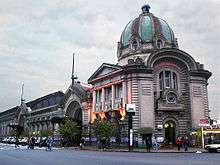
La Plata is mostly served by the Roca Line, including the University train of La Plata, which runs from the central station to the National University of La Plata.[92] The segment of the Roca Line which runs from Buenos Aires Constitución to La Plata and its suburbs is electrified with new rolling stock, stations and track, with works having commenced in 2014 and completed in 2017.[93]
This line also provides commuter services to La Plata's city centre from neighborhoods like Tolosa, Ringuelet, City Bell and Villa Elisa, with a frequency of one train every 25 minutes, which is expected to drop to 12 minutes after the electrification is completed.[94] Up until the 1980s, there were also other commuter services on the General Roca Railway to nearby towns and suburbs, however they are no longer in use and there are no indications that they will be reactivated.[95]
Mendoza
The Metrotranvía Mendoza (Spanish for Mendoza Light Rail or fast tramway) is a public light rail transport system for the city of Mendoza, Argentina, served by articulated light rail cars operating on newly relaid tracks in former-Ferrocarril General San Martín mainline right-of-way. The tram system is unusual in the sense that, unlike the rest of railway services in Argentina,[96] the rail cars on this line run on the righthand track instead of the left.
The tram serves the metropolitan area of Mendoza, which includes the departments of Las Heras, Central district, Godoy Cruz, Maipú and Luján de Cuyo. As of 2013, only one line runs a 12.5 km (8 mi) stretch between Mendoza Central Station and General Gutierrez in Maipú, on double-track 1,435 mm (4 ft 8 1⁄2 in) standard gauge track.[97] The finished project includes four lines, 46.5 km (29 mi) in length and 50 stations, also connecting downtown with the Airport.[98][99]
Construction of the first line (Línea Verde, or Green Line)[100] began in March 2009.[101] The system opened for regular service on 8 October 2012.[100] In February 2014, the local Government announced the start of constructing works for the second line, linking the city centre with the North, up to Panquehua, in Las Heras Department.[102]
Neuquén
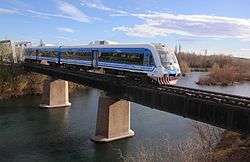
The Tren del Valle (Train of the Valley) is a service that runs between the cities of Neuquén and Cipolletti in Neuquén and Río Negro provinces, expected to begin operating in July 2015 with 22 services per day.[103] While in the first phase of the reactivation of this line (closed in the 1990s after the privatisation of the network) takes it between these two cities, after the opening, it will continue to be extended to General Roca, Plottier and Añelo in 2015 and 2016.[104][105] The line uses Argentine-built Materfer CMM 400-2 DMUs and General Roca Railway tracks, which have been replaced along with the restoration of existing railway bridges, while parts of its route will be shared with YPF freight services that serve the vast Vaca Muerta oil fields in the provinces.[103][106][107] This line was once operated by the Buenos Aires Great Southern Railway, before railway nationalisation in 1948.
Paraná
The Paraná urban railway is served by two local lines which run on the standard gauge General Urquiza Railway and link Paraná city -Capital of Entre Ríos province- with Colonia Avellaneda and Villa Fontana. The two lines are 9 and 13.4 km long, but there are further plans to expand the system. Villa Fontana's line was inaugurated in August 2010 up to Oro Verde and expanded to Villa Fontana in 2011. Colonia Avellaneda's line was inaugurated in March 2011.[108][109]
Paraná city is also linked with interurban services to Concepción del Uruguay and Concordia, Entre Rios' main cities.[110]
Resistencia
It serves Great Resistencia, the capital city of the province of Chaco with a 10 km line to Puerto Vilelas with 8 stations, and a 20 km line to Puerto Tirol with 16 stations. From the intermediate station of Cacuí in the Puerto Tirol Line leaves the interstate line to Los Amores in the province of Santa Fe. The whole network uses the former General Belgrano Railway 1,000 mm (3 ft 3 3⁄8 in) gauge tracks.[111]
The system was originally operated by Chaco Railway Services, owned by the Province's Government, but in May 2010 operation was transferred to SOFSE, the state-owned railway company managed by the National Government.[112]
Santa Fe
The Santa Fe Urban Train is project initiated in 2014 for a 3.7 km line which runs through the city of Santa Fe in Santa Fe Province using metre gauge General Belgrano Railway tracks.[113] In June 2015, the service underwent successful testing on the line and its 8 brand new stops, using Argentine-built TecnoTren railbuses.[114] Once fully opened in 2015, this will be the first commuter rail service in the city since railway privatisation in the 1990s, while it is estimated that using the train will be 40% faster than existing bus transport.[115][116]
Santiago del Estero
The historical city of Santiago del Estero will have a commuter rail service called Tren al Desarrollo, which will run on a series of newly built viaducts over the city, as well as existing General Mitre Railway broad gauge tracks.[117] The 8 km line has undergone testing using Argentine TecnoTren rolling stock and will open to the public in 2016, though its central terminus was inaugurated in 2015.[118][119][120] After its aperture, the line will be further extended to the outskirts of the city, though it has also been considered to extend the line to the nearby city of San Miguel de Tucumán.[121][122]
Historical networks
Up until the mid-twentieth century, most major cities in Argentina had a tramway network, though today only a small number remain.[124][125] La Plata was the first Argentine city to receive an electric tramway network in 1892, rather than Buenos Aires which would see its existing network electrified from 1897 onwards.[71] By the mid-1960s, most cities had their tram networks dismantled and replaced with colectivos and trolleybuses. La Plata was the last city to operate trams in Argentina, with its last service operating in December 1966, until the 1980s when the Buenos Aires PreMetro began operations.[74][125]
Mass transit
Buenos Aires Underground
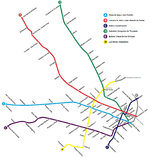
.jpg)
The Buenos Aires Underground (Subterráneo de Buenos Aires-locally known as Subte) is a metro system that serves the city of Buenos Aires, the network was inaugurated in 1913 by the Anglo-Argentine Tramways Company, being the first of its kind in Latin America and in the entire Southern Hemisphere and Spanish speaking world.[126]
It currently has six lines, with a seventh underway a further two planned, carrying 365 million passengers per year on a 52 km (32 mi) network with 83 stations.[127][128] The network expanded quickly in its early years, but the rate of expansion had slowed by the 1960s, with serious attempts at expansion and modernisation only occurring in recent years.[129]
Other projects

In the city of Córdoba, Argentina, there is a project to build an underground system; the Córdoba Metro, which would make it the second metro system in Argentina.[130] The network will be 33 kilometres long with 26 stations on 3 lines, with a total cost of $1.8 billion.[131] The city of Rosario has also proposed having its own metro system, which is currently being evaluated.[132]
Work has also begun in Buenos Aires to move the Sarmiento Line underground in an effort to decrease journey times whilst improving traffic conditions above ground. The project will be undertaken in three stages and, when completed, would mean that 32.6 kilometres of the line between Caballito and Moreno will be completely underground, with station entrances above ground similar to a metro system.[133] The existing above-ground line has continued to operate while work has occurred below ground for the corresponding sections.[134][135]
There is also a project announced in 2015 to create a 16 km (9.9 mi) series of tunnels to connect Retiro railway station, Once railway station and Constitución railway station.[136] The result of this would be the Red de Expresos Regionales, which would link together all of Buenos Aires' existing 812 km (505 mi) commuter rail network, allowing for passengers to travel from one side of Greater Buenos Aires to the other making only one connection at a central underground station underneath the Obelisco. The project will cost $1.8 billion and will be carried out in three stages, taking 8 years for it to be fully completed, though some parts are due to commence operation sooner.[60]
Intercity passenger services
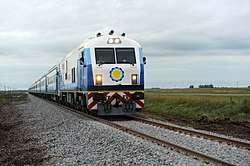

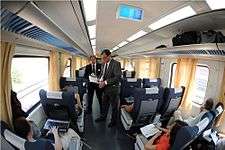
Argentina scrapped many of its uneconomical long-distance passenger train services during the early 1990s and privatised, by concession contract, several main routes to Trenes de Buenos Aires (TBA), Ferrocentral, Ferrobaires, and Trenes Especiales Argentinos. The new services were not what passengers were used to and, with the exception of the Buenos Aires, Rosario, Córdoba and Tucumán corridors, provided erratic and poor-quality services. In recent years however, government policy has changed to one in which the state intends to re-open and operate all services which were formally closed.[137]
Under privatisation, many services ceased to operate for a variety of reasons. Among these were previously iconic routes such as Buenos Aires - Posadas and Buenos Aires - Bariloche.[138][139] Recently however, the national government has been replacing very large segments of track in important corridors and routes, using continuous welded rails on concrete sleepers to accommodate trains running at speeds of 160 km/h.[140][141] Many of these improvements are nearing completion while others are under way and some are in the planning stages. Long-distance rail travel in Argentina has been described as considerably cheaper than air or bus travel, but also much slower, with maximum speeds of 50 km/h even on the newer stretches opened in 2017.[142]
In 2014 there was a 600% increase in spending on railway infrastructure, being spent on projects around the country to revive long distance services, while this expendature is expected to be even higher in 2015.[143][144] To accommodate this revival in long distance services, Retiro railway station will receive a new expansion for the services being operated by SOFSE.[145] Similar projects are nearing completion in cities like Rosario, where a completely new railway terminal has been built in addition to the existing ones.[146]
At the same time, the high speed rail project which had been planned for the Buenos Aires - Rosario - Córdoba corridor has been put on hold since for the moment the routes are being refurbished for the 160 km/h services which are considered to be a higher priority, though as of 2015, Chinese proposals for high speed rail are still being considered.[147][148]
Routes
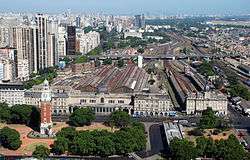
Inter-city services are currently served by two State-owned railway companies, Trenes Argentinos (that manages all the long-distance passenger rail services) and Ferrobaires (operating services in Buenos Aires Province). Ferrobaires has been criticised for the quality of its service,[149] though there have been signs that the company (owned by the province of Buenos Aires, rather than the national government) may be dissolved when its remaining services are taken over by Trenes Argentinos.[150]
Nowadays, some of the most important cities of Argentina are served by train, departing from Constitucion, Once and Retiro terminus located in the centre of Buenos Aires. Some cities currently are: Mar del Plata, Rosario (both stations, Norte and Sur, Córdoba, General Pico, Santa Rosa, Rufino and San Miguel de Tucumán.[151]
Other regional services are operated by their respectives Provinces, such as Tren a las Nubes (operated by the Government of Salta) and Servicios Ferroviarios Patagónico (also known as "Tren Patagónico") by the Río Negro Province.
Tourist railways
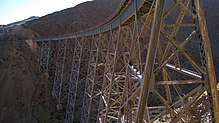
Buenos Aires
- Avellaneda Park Historic Train, a miniature railway which runs through a park in the west of the city, reopened in 2015 after 9 years without services.[152]
- Capilla del Señor Historic Train was an 80 km (50 mi) heritage railway operated by the Ferroclub Argentino. The train was pulled by steam locomotives, running on tracks originally built by Buenos Aires Central Railway. The service ceased in 2011.
- The "Tranvía Histórico de Buenos Aires" is a Heritage Tramway inaugurated in 1980 in the Caballito neighborhood on existing vintage street tracks.[70]
Córdoba
- Tren de las Sierras is a 150 km (93 mi) 1,000 mm (3 ft 3 3⁄8 in) railway line between Alta Córdoba station in the centre of the city of Córdoba and Cosquín.[153] It's popular with tourists because of its scenic route through the "Sierras Chicas" of Córdoba Province.
Entre Ríos
- Villa Elisa Historic Train was opened and operated by "Ferroclub Central Entrerriano", a local non-profit association formed by railway enthusiasts. Since then, the service has been running trains pulled by steam locomotives between the cities of Villa Elisa and Caseros in Entre Ríos Province, covering a distance of 36 km (22 mi),[154] with a total journey time of 120 minutes.[155]
Mendoza
- The "Wine Train" (Tren del Vino) was a project that would provide railway transportation to locals, running along wine producing districts of Mendoza.[156] The route had been set from cities of La Colonia (in Alto Verde) to Luján de Cuyo with diesel locomotive trains with 3 coaches each. Despite of its opening had been announced for 2008,[157] Tren del Vino never made its inaugural trip. Nevertheless, in April 2014 state-owned Trenes Argentinos Cargas y Logística took over the transportation of wine, carrying the production of Mendoza Province.[158]
Misiones
- The Rainforest Ecological Train is a small environmentally friendly train that runs for 3.7 km (2 mi) through the rainforest inside Iguazú National Park in the north of the province of Misiones.[159]
Patagonia
- The narrow-gauge "Old Patagonian Expres" (popularly known as La Trochita), is a 402 km (250 mi) long narrow gauge 750 mm (2 ft 5 1⁄2 in) heritage railway in Patagonia using steam locomotives. It is said to be the only narrow-gauge long-distance steam train in operation in the world.[160][161]
- The "Tren Histórico a Vapor" was a short run from Bariloche to Perito Moreno, 4-6-0 steam manufactured in Scotland in 1912 by the North British Locomotive Company in Glasgow, the Cedar and Mahogany carriages were originally made in England. The service was opened in 2001[162] although it was closed later, remaining inactive up until the present day.
Rosario
- The Bicentennial Tramway runs through the city of Rosario with two different routes and a total of 19 stops.[163] Rosario got its first trams in 1906, however after they closed in 1962 much of the track was covered in tarmac, so the vintage units have been converted to run on rubber tires.[164][165] In June 2015, a heritage tram began running on rails using one of the original trams from the restored network; the intention is to provide more heritage services and restore more trams.[166]
Salta
- Tren a las Nubes in the province of Salta crosses canyons and cliffs before arriving at San Antonio de los Cobres. The railway is approximately 4,220 metres (13,850 ft) above mean sea level, while its tracks and rolling stock were refurbished in 2015.[167][168][169]
Tierra del Fuego
- The Southern Fuegian Railway, called "Tren del Fin del Mundo" - "The Train at the End of the World", is the world's southernmost railway in the province of Tierra del Fuego, operating on narrow gauge 500 mm (19 3⁄4 in), using steam locomotives.[170]
Freight
There are several private freight operators in Argentina, along with the state-owned Trenes Argentinos Cargas y Logística. In 2012, the network carried 12,111 million tonne-kilometres (tonnes x distance travelled).[171] The amount of freight carried by individual operators in 2014 was as follows:
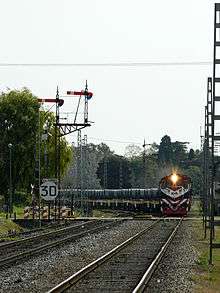
| Operator | Freight carried (tonnes) [172] | Type |
|---|---|---|
| Nuevo Central Argentino | 7,408,914 | Private |
| Ferrosur Roca | 5,258,301 | Private |
| Ferroexpreso Pampeano | 3,500,009 | Private |
| TACyL | 3,155,301 | State-owned |
| Total: | 19,317,525 | - |
Trenes Argentinos Cargas y Logistica (TACyL) is a state-owned company created out of the Belgrano Cargas network after the national government terminated the company's contract in 2013, returning it to state control while citing the lack of competitiveness in the private sector as a primary reason for the move.[173][174] Later that year, the government revoked concessions from Brazilian company América Latina Logística citing "serious" contract violations and imposing heavy fines one the company for being in breach of contract.[175] The services managed by this company were also integrated into the new TACyL holding company.[176]
Following the creation of TACyL, the national government began investing heavily in the country's freight network with an AR$12 billion investment to improve its infrastructure, renewing 30% of the rails over the following 2 years.[177] This investment also included purchasing 100 locomotives and 3,500 freight cars from China for TACyL which are expected to arrive in 2015, while a separate investment saw the purchase of a further 1,000 cars from Argentine company Fabricaciones Militares.[177][178] Further renovation of infrastructure for passenger lines, such as the complete replacement of rails on the Buenos Aires - Rosario - Córdoba - Tucumán route of the General Mitre Railway, will aid private operators such as Nuevo Central Argentino who use those segments.[179][180]
Soon after nationalisation, the government began looking to expand the fleet of the company and began making orders both domestically and abroad. One order consisted of 1000 freight wagons from Argentine state-owned company Fabricaciones Militares.[178] The company also ordered 100 locomotives and 3,500 carriages from China as part of a plan that also included the purchase of 30,000 rails to repair parts of the line.[181] In September 2015, it was announced that the original Chinese investment of US$2.4 billion in the Argentine freight network was being doubled to US$4.8 billion and new purchases and infrastructure projects would ensue.[182]
Rolling stock
Prior to the deterioration of the rail network, Argentina had a greater number of rolling stock manufacturers which supplied trains and cars throughout the railways, however today only a few companies like Materfer, Grupo Emepa, TecnoTren and Fabricaciones Militares remain. While Materfer make the CMM 400-2 diesel multiple units and the MTF-3300 diesel cargo locomotives, Emepa manufacture the Alerce EMU/DMU which is to be used on the Belgrano Norte Line.[183][184] At the same time, Fabricaciones Militares only makes freight cars, such as those used in the Belgrano Cargas network, though in the past they made electric trains for suburban and underground lines.[178] There have been signs that the industry is reviving and expanding, while at the same time there are many workshops around the country which refurbish and modernise older rolling stock.[185][186]
Though the industry is being revived, the country no longer has the capacity to manufacture long-distance locomotives and EMUs for suburban lines, so these are mostly imported from China and are made by companies such as CSR Corporation Limited and China CNR Corporation, with CSR planning to open a factory in Argentina and purchasing the Argentine company Emprendimientos Ferroviarios, which is now its subsidiary.[187][188]
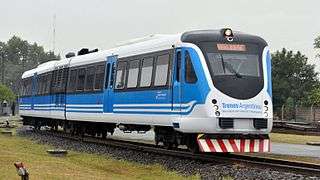 An Emepa Alerce DMU
An Emepa Alerce DMU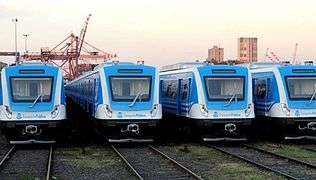
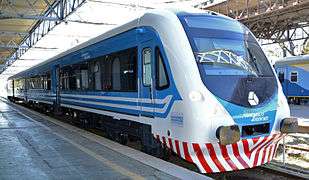 A Materfer CMM 400-2 on the Tren del Valle
A Materfer CMM 400-2 on the Tren del Valle EMD locomotives are widely used for freight
EMD locomotives are widely used for freight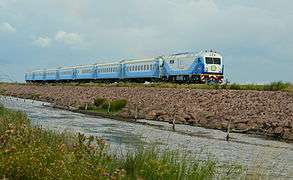 CNR CKD8 long distance rolling stock
CNR CKD8 long distance rolling stock A CSR SDD7 train on the San Martín Line
A CSR SDD7 train on the San Martín Line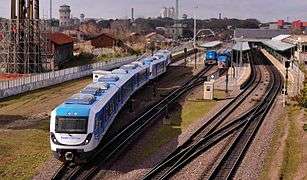 A Belgrano Sur Line CNR DMU
A Belgrano Sur Line CNR DMU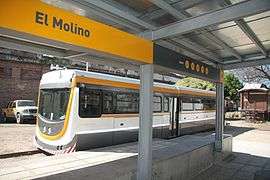
International rail links to adjacent countries







Incidents

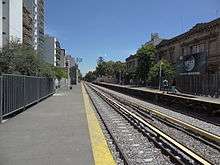
The worst rail accident in Argentina in terms of fatalities occurred on 1 February 1970 when two trains collided near Ingeniero Maschwitz in Greater Buenos Aires.[193][194] This due to a passenger train carrying 700 people coming to a halt with mechanical problems, while a long distance General Mitre Railway train carrying 500 passengers from Tucumán crashed into it from behind.[195] The total death toll was 142 people, with 368 injured.[195][196]
From 2008 to 2012, there were a series of rail accidents which eventually led to the re-nationalisation of the rail network. Before dawn on 9 March 2008, a passenger train slammed into a bus at a rural Argentine level crossing, near Dolores, some 125 miles (201 km) south of Buenos Aires, killing 18 people and leaving at least 47 others injured. The bus driver ignored the warning lights and lowered crossing gates.[197]
On 13 September 2011, passenger train operated by Trenes de Buenos Aires hit a bus on a level crossing at Flores in Buenos Aires during the morning rush hour, killing 11 people and injuring 265.[198] The train derailed, and crashed into a train standing at the platform in the adjacent station. The bus driver had ignored warning lights and a partly lowered barrier.[199]
The second-worst rail accident in terms of fatalities occurred on 22 February 2012 a passenger train operated by TBA crashed into the solid buffers at the Once station near downtown Buenos Aires, killing 51 people and injuring over 700 others.[200][201] President Cristina Fernández de Kirchner called for two days of national mourning following the accident.[202]
Following these accidents, all of TBA's concessions were revoked and the national government began restoring rail infrastructure and purchasing brand new rolling stock for Buenos Aires' commuter rail lines, as well as huge investment across the country.[5][143][203] These moves eventually led to the complete re-nationalisation of the country's railway network, with safety concerns under private operation being one of the primary reasons.[204][205]
See also
- Transportation in Argentina
- Buenos Aires Underground
- Ferrocarriles Argentinos (2015)
- Rail transport by country
- State-owned Argentine Railway Companies
References
- "Crece 30 por ciento el número de pasajeros del ferrocarril". La Capital. 6 November 2018. Retrieved 7 September 2019.
- CIA World Factbook - Argentina
- Resolution 163/2015 - Infoleg (in Spanish)
- Estaciones nuevas y modernas para las lineas metropolitanas - ADIFSE, December 2014
- Comenzaron a funcionar los nuevos trenes - ADIFSE, November 2014
- Así es el proyecto que recrea Ferrocarriles Argentinos - EnElSubte, March 2015
- Otro salto en la recuperación de soberanía - Pagina/12, 16 April 2015
- Es ley la creación de Ferrocarriles Argentinos - EnElSubte, 15 April 2015
- Ferrocarriles Argentinos: Randazzo agradeció a la oposición parlamentaria por acompañar en su recuperación - Sala de Prensa de la Republica Argentina, 15 April 2015
- The tragedy of Argentina: A century of decline - The Economist, 14 February 2014
- Breve Historia de los FERROCARRILES ARGENTINOS, su Construcción, su Destrucción, su Importancia, y Proyecto de Recuperación. - Universidad Tecnologica Nacional, 2013, p.6
- El Ferrocarril en La Argentina - Ferrocarriles del Sud, August 2011
- Ferrocarriles Argentinos: una historia de entrega y de luchas - Soy Ferroviario, 2 April 2015.
- Breve Reseña - La Fraternidad
- Los Ferrocarriles: Sus orígenes - TodoTren
- Breve Historia de los Ferrocarriles Argentinos - La Gazeta
- Currency converter - The National Archives
- Breve Historia de los FERROCARRILES ARGENTINOS, su Construcción, su Destrucción, su Importancia, y Proyecto de Recuperación. - Universidad Tecnologica Nacional, 2013, p.22
- Ortiz, Raúl Scalabrini (2006). Historia de los Ferrocarriles Argentinos. Lancelot. p. 32. ISBN 978-9871677979.
- Thompson, Andrew (1992). "Informal Empire? An Exploration in the History of Anglo-Argentine Relations, 1810-1914". Journal of Latin American Studies. 24 (2): 419–436. doi:10.1017/S0022216X00023440.
- Ferrocarriles del Estado at CEPAL Library
- Breve historia de los ferrocarriles argentinos: entre la nacionalización y la privatización - Notas, 9 April 2015.
- "Argentina's Economic Crisis: An "Absence of Capitalism"". Heritage.org. 19 April 2001. Archived from the original on 8 December 2011.
- Breve Historia de los FERROCARRILES ARGENTINOS, su Construcción, su Destrucción, su Importancia, y Proyecto de Recuperación. - Universidad Tecnologica Nacional, 2013, p.24
- Crisis y Nacionalización Ferroviaria. - La Fraternidad
- JSTOR: The Economic Journal, Vol. 68, No. 271 (Sept., 1958), pp.589-593 - Retrieved on 14 June 2008
- Juan Domingo Perón anuncia la nacionalización de los ferrocarriles "Juan Domingo Perón anuncia la nacionalización de los ferrocarriles.", Argentina.ar, 1 Mar 2015
- "1945 Britain – Imperial ambitions of a starving nation" - 2nd Look, December 2009
- La red ferroviaria argentina - Ministerio de Educacion
- Los Ferrocarriles: Sus orígenes - Todo Tren
- BREVE HISTORIA DE LOS FERROCARRILES ARGENTINOS - La Gazeta
- El primer objetivo estratégico La Independencia Económica, una de las tres banderas del justicialismo Cuadro de situación financiero en 1946 - Historia del Peronismo
- El plan Larkin y la resistencia obrera - Laguna Paiva
- Historia de los Organismos y Empresas del Estado: Ferrocarriles Argentinos - Ministerio de Planificacion
- El Proceso de Concesión y Desarme de Ferrocarriles Argentinos - La Fraternidad
- El SISTEMA FERROVIARIO DE LA REPÚBLICA ARGENTINA - Revista Geográfica Digital, January 2013
- Breve historia de la privatización de los ferrocarriles en la Argentina - Tiempo Argentino, February 2012
- Encyclopædia Britannica. Book of the Year, 1986. World Affairs: Argentina.
- Argentina Meeting Bankers In Effort To Cut Its Huge Debt - Chicago Tribune, 29 January 1992.
- Teubal, Miguel (1 September 2004). "Rise and Collapse of Neoliberalism in Argentina" (PDF). Journal of Developing Societies. 20 (3–4): 173–188. doi:10.1177/0169796X04050957. Retrieved 28 May 2015.
- Rodríguez-Boetsch, Leopoldo (19 January 2007). "Public service privatisation and crisis in Argentina". Development in Practice. 15 (3–4): 302–315. doi:10.1080/09614520500076092.
- El proceso de privatizaciones en la Argentina desde una perspectiva del Balance de Pagos - MECON
- Privatisation Derailed Argentina’s Rail System - IPS News, 24 February 2012.
- El servicio ferroviario argentino de las últimas dos décadas, el antes y después de las privatizaciones - Monografias.com
- Privatización de los ferrocarriles: "Ramal que para, ramal que cierra" - Contra Molinos de Sortilegios, 24 July 2013
- Como Perdimos el Ferrocarril Agentino - Ancaloo, 29 September 2008
- El regreso del tren de cargas al Mercado Central "favorecerá a la pequeña y mediana empresa" - Telam, 6 May 2015.
- Argentina sets a new course. Railway Gazette International, Retrieved on 19 May 2008
- "Finalmente, el Gobierno le sacó las concesiones del Sarmiento y del Mitre a TBA". Clarín.
- "El gobierno nacional estatizó los ferrocarriles Sarmiento y Mitre", Infobae
- "ALL concessions revoked". Railway Gazette International. Retrieved 10 June 2013.
- "Nueva empresa estatal para el Belgrano Cargas", Página/12, 23 May 2013
- Randazzo: "Estamos saldando una deuda con las ciudades del interior del país"
- Exitosa prueba en la renovada vía a Rosario EnElSubte, March 2015
- Rescinden contratos a privados y vuelve Ferrocarriles Argentinos EnElSubte, March 2015
- Randazzo: "Este paso bajo nivel es parte del importante proceso de renovación ferroviaria de la Línea Sarmiento" - Crónica Ferroviaria, February 2015
- A tres meses del cambio de Gobierno, firman un acuerdo ferroviario por US$ 2.400 millones - Clarín, 8 September 2015.
- Invertirán este año 9.000 millones de pesos para mejorar la infraestructura ferroviaria - Telam, 25 May 2015.
- Detalles del proyecto para conectar todos los ferrocarriles urbanos debajo del Obelisco - Buenos Aires Ciudad, 12 May 2015.
- Estadísticas del transporte ferroviario - Total 2014, CNRT website - Ministry of Transport
- Elevarán las trazas del ferrocarril San Martín y del Belgrano Sur - InfoBAE, 16 December 2014.
- Mapa de la red - Metrovías
- Inauguraron el nuevo centro de transbordo Sáenz - EnElSubte, 19 March 2015.
- Servicios líneas metropolitanas - SOFSE
- SUBE - Ministerio del Interior y Transporte.
- Reshaping Argentina's Railways, Japan Railway & Transport Review No. 2 (pp.23–29) Retrieved on 24 June 2008
- servicios líneas metropolitanas - SOFSE
- Historia del tranvía en Buenos Aires - Revista Digital ead
- Un viaje por la historia de la ciudad en el viejo Tramway - ElDiario.es, 21 March 2015.
- APUNTES SOBRE LA HISTORIA DEL TRANVÍA EN BUENOS AIRES - Biblioteca Popular Federico Lacroze
- La línea Maipú-Delta, un potencial desaprovechado - EnElSubte, 20 April 2015.
- El tren de Puerto Madero, ocho meses sin servicio y un futuro incierto - Cronista, 23 May 2013
- Cross, Barry (April 2001). "Buenos Aires: Brand new pre-Metro line". Tramways & Urban Transit, pp. 136–137. UK: Light Rail Transit Association/Ian Allan Publishing.
- La AAT celebra con un festival los 150 años del tranvía - EnElSubte, 12 July 2013
- "Nuestra compañía - ¿Qué hacemos?" [Our Company - What We Do] (in Spanish). Metrovias. Retrieved 29 May 2015.
- ¿Por qué la línea D no llega hasta Puente Saavedra? - EnElSubte, 25 June 2013.
- Premetro a Puente de la Noria, en el olvido por el Metrobus del Sur - EnElSubte, 16 August 2013.
- Proponen que el Premetro absorba el recorrido del Metrobus del Sur -
- Plan "canje" de electrodomésticos, beneficios con la tarjeta SUBE y subsidio a las garrafas - Tiempo, 27 March 2015.
- Tarifas - Tren Mitre
- Creación del Boleto Docente para el Transporte Público ferroviario y automotor - Crónica Ferroviaria, 18 March 2015
- Los trenes que se vienen desde China - Pagina/12, 23 September 2013.
- Electrificarán todos los ramales del Ferrocarril Roca Retrieved on 23 June 2008 (Spanish)
- Informe Anual 2012 - Ministerio del Interior y Transporte, 6 June 2013
- Se inauguró el Roca eléctrico a La Plata - En El Subte.com, 18 October 2017
- Ya funciona el Roca Vía Circuito - En El Subte.com, 12 October 2018
- El tren San Martín será eléctrico - Argentina.gob.ar, 23 July 2018.
- Tras reunirse con autoridades del BID, Randazzo señaló que "Argentina obtendrá financiamiento para otros importantes proyectos ferroviarios" - Ministerio del Interior y Transporte, 4 August 2015.
- Anunciaron la electrificación del Sarmiento hasta Mercedes - El Nuevo Cronista, 27 March 2015
- Randazzo: "Quiero comprometerme aquí a que en los próximos años, no más allá de 24 meses, se inicie el proceso de electrificación del ferrocarril hasta Mercedes" - Crónica Ferroviaria, 27 March 2015
- "Comenzó a rodar el Tren Universitario", University of La Plata
- La Presidenta presentó los 300 vagones cero kilómetro destinados al ferrocarril Roca , que a fin de año estará electrificado - Sala De Prensa de La Republica Argentina, 5 March 2015
- Comenzaron las obras de electrificación del ramal Constitución - La Plata - InfoBae, 3 December 2014
- Ramal LA PLATA - PIPINAS "El Tren Lechero" - La Pagina del Rio de La Plata, 14 January 2004.
- El día en que Argentina dejó de manejar por la izquierda - Autoblog, 23 September 2014
- Ya ejecutaron el 55% de las obras del metrotranvía - Jornada Online, 20 July 2010.
- "Preparan el terreno para los rieles del Metrotranvía a Las Heras", Los Andes, 22 January 2015.
- "Proyectos para los recorridos del Metrotranvía al Aeropuerto, Luján y Maipú", Diario Uno, 19 January 2015.
- "Mendoza light rail service begins" (December 2012). Tramways & Urban Transit, p. 451. LRTA Publishing. ISSN 1460-8324.
- "Metrotranvía deal signed". Railway Gazette International. 24 February 2009. Retrieved 9 July 2013.
- "Second stage of Metrotranvía signed by Government". Info News Mendoza. 31 January 2014. Retrieved 12 February 2014.
- Randazzo anunció que el tren del valle entre Cipolletti y Neuquén comenzará a funcionar el 20 de julio - Telam, 2 June 2015.
- Randazzo pone fecha a llegada a Roca del tren del Alto Valle - Rio Negro, 2 June 2015.
- Tren del Valle: Reuniones para que llegue hasta Plottier y Senillosa - Municipalidad de Plottier
- En pocos dias vuelve el Tren a Neuquén y Río Negro - Taringa!, 8 June 2015.
- Randazzo anunció que el Tren del Valle llegará hasta Plottier y Roca - Mejor Informado, 2 June 2015.
- Paraná - Oro Verde - Cnia. Avellaneda en Satélite Ferroviario
- Horarios Paraná - Colonia Avellaneda - Trenes Argentinos
- Sofse: Parece que la solución vino rápida y el tren de pasajeros ahora llega hasta Concordia - Cronica Ferroviaria, 4 April 2014
- "Sefecha pasó a la Nación" (in Spanish). Resistencia: Editorial Chaco S.A. 10 May 2010. Retrieved 2 May 2013.
- Proyecto Tren Urbano - Santa Fe Ciudad, 5 June 2015.
- Probaron el tren urbano - El Litoral, 8 June 2015.
- El Tren Urbano aprobó el examen y funcionó sin problemas en las vías - UNO Santa Fe, 8 June 2015.
- El futuro tren urbano realizará su recorrido en solo 10 minutos - DERF, 9 January 2015.
- "Tren al Desarrollo, obra pronto a ser inaugurada", SDE Government
- "Randazzo visitó la futura estación del "Tren al Desarrollo" en Santiago del Estero", Telam, 17 Jun 2014
- "Santiago del Estero: La estación Fórum del Tren del Desarrollo impacta por su diseño" on Crónica Ferroviaria, 11 May 2015
- "Iniciarán pruebas del Tren al Desarrollo en la estación Fórum", El Liberal, 12 May 2015
- "El tren al desarrollo unirá Santiago, Banda y Las Termas", El Liberal, 18 Jun 2014
- "El Tren al Desarrollo unirá Santiago del Estero y Tucumán", Cadena3, 20 Jun 2014
- Los tranvías de Rosario vuelven de la historia - Pagina/12, 25 November 2007.
- Morrison, Allen (1996). Latin America by Streetcar. New York: Bonde Press. pp. 143, 157. ISBN 978-0-9622348-3-5.
- Tranvias Argentinos - Tranvias de Cordoba
- Se cumplieron 100 años del primer viaje en subte - Ambito, 1 December 2013.
- Aumentó un 12% la cantidad de usuarios que usan el subte a diario - La Nacion, 7 May 2015.
- SBASE planea dejar iniciada la línea F para 2015 - EnElSubte, 10 September 2014
- Planes e Inversiones - Buenos Aires Ciudad
- Diario La Voz Del Interior Retrieved on 10 July 2009 (Spanish)
- Córdoba metro redesigned - Railway Gazette, 19 February 2012
- Reimpulsan la construcción de un Subte en Rosario - EnElSubte, 29 July 2014
- Soterramiento del Ferrocarril Sarmiento - Secretaria de Transporte, 8 September 2011
- Ceremony marks start of Sarmiento tunnelling - Railroad Gazette, 5 July 2012
- Fotos de la obra del soterramiento del Ferrocarril Sarmiento - Taringa!
- Macri promete una estación central debajo del Obelisco - La Nacion, 9 May 2015.
- Randazzo: "Ramal que arranca no para nunca más" - Sala de prensa de la Republica Argentina, 28 February 2015
- F. Lacroze - Apóstoles - Posadas - Satelite Ferroviario, 8 December 2014
- Viedma - Jacobacci - Bariloche - Satelite Ferroviario, 16 March 2015
- Tren a Rosario arranca el miercoles: tardara 6:30 horas - EnElSubte
- Mar del Plata: Día a día avanzan las obras de renovación de vía - Crónica Ferroviaria, 2 April 2015
- "¿CÓMO SE VIAJA EN LOS TRENES ARGENTINOS DE LARGA DISTANCIA?". Turismo de Bolsillo. Retrieved 17 August 2019.
- Se publican en la web las obras ferroviarias de ADIF y sus contratos - ADIFSE, 26 May 2014
- Obras - ADIFSE
- Nuevo acceso y andenes para larga distancia en Retiro Mitre - EnElSubte, 2 April 2015
- Se ultiman detalles para la llegada del tren a Rosario - ADIFSE, 26 January 2015
- Randazzo sepulta el proyecto de tren bala a Córdoba - La Voz, 20 December 2012
- El tren chino de alta velocidad vigoriza América Latina - People Daily, 26 January 2015
- Randazzo volvió a atacar con dureza a Scioli - La Nacion, 13 March 2015
- El caso Ferrobaires - Cronica Ferroviaria, 24 March 2015
- Horarios y Destinos - Satelite Ferroviario
- Los vecinos del parque Avellaneda volvieron a disfrutar del histórico "tren de la alegría" - La Nacion, 2 September 2015.
- "Randazzo recibió el tren que vuelve a unir Alta Córdoba con Cosquín", Ministerio del Interior y Trasporte, 17 Mar 2015
- Tren turístico de Villa Elisa on Girasol Hostería
- "15 trenes turísticos de la Argentina", Clarín, 24 May 2015
- Mendoza Wine Train, 26 May 2008
- "El Tren del Vino comenzará a rodar por Mendoza en 2008", Los Andes, 10 Nov 2007
- "Salió de Mendoza el primer tren con vino, el mismo que usará San Juan", San Juan 8, Apr 2015
- Rainforest Train - Iguazu National Park
- Ingeniero Jacobacci Journal; Old Patagonian Express Puff, Puff, Puffs to Its End - New York Times, 20 June 1992.
- The Old Patagonian Express - Narrow Gauge Heaven,
- "Accidentado viaje inaugural de un tren de vapor en Bariloche", La Nación, 14 Jul 2001
- Recorridos - El Tranvia del Bicentinario
- Imágenes - El Tranvia del Bicentinario
- A un siglo de su puesta en marcha, quieren que vuelva a rodar un tranvía - La Capital, 29 October 2006
- El tranvía histórico de Rosario vuelve a circular este domingo - Impulso, 6 June 2015.
- El Tren a las Nubes - El Sol, 7 April 2015
- Después de ocho meses, volvió el Tren a las Nubes - La Nacion, 5 April 2015
- "El tren más famoso del país vuelve a las nubes", Perfil, 1 Apr 2015
- 'Transported' for life... Ushuaia Prison - 'The Presidio' - Railways of the Far South, 25 May 2008.
- Railways, goods transported (million ton-km) - World Bank
- 7,1% menos de carga transportada por ferrocarril en el 2014, Bolsa de Comercio de Rosario, 13 February 2015.
- "Belgrano Railway returns to state control". Railway Gazette International. Retrieved 27 May 2015.
- "Estatizan el ferrocarril Belgrano Cargas", La Nación, 23 May 2013
- Argentina Seizes Railway From Brazil’s ALL Over Contract Breach - Bloomberg, 4 June 2013.
- Gobierno anunció estatización del ferrocarril de cargas América Latina Logística - Argentina.ar, 4 June 2013.
- Apuntan a recuperar los trenes de cargas con una inversión de casi 12.000 millones de pesos - Telam, 16 November 2014.
- Fabricaciones Militares construirá más de 1000 vagones para el Belgrano Cargas - Fabricaciones Militares
- Realizaron primera apertura de sobres de la renovación de vías a Córdoba - EnElSubte, 30 April 2015.
- Nuestra Red - Nuevo Central Argentino
- Avanza la renovación del Belgrano Cargas con financiamiento chino - Telam, 14 February 2015.
- Duplicarán el crédito chino para cargas: invertirán más de 4800 millones de USD - EnElSubte, 14 September 2015.
- Nuevo servicio diferencial en el Belgrano Norte, con coches de fabricación nacional - Secretaria de Transporte, 25 March 2015
- Ferroviario - Materfer
- Técnicos españoles colaborarán con la recuperación de los talleres ferroviarios argentinos - Telam, 23 July 2013
- Tecnología e innovación ferroviaria en la Argentina - Pagina/12, 19 April 2014
- La fábrica de trenes china CSR Sifang se instalará en la Argentina - Telam, 4 November 2014
- CSR adquiere EMFER y desembarca en la Argentina - EnElSubte, 24 February 2014.
- Initiative for Regional Infrastructure Integration in South America
- En julio se licitará tren Los Andes - Mendoza Retrieved on 26 May 2008 (Spanish)
- "Empezó a circular el tren que une Posadas y Encarnación", Territorio Digital, January 2015
- "El tren que unía Argentina y Uruguay dejó de funcionar de modo definitivo", El Día, 28 May 2012
- Un convoy del Ferrocarril General Mitre (hoy NCA), proveniente de Tucumán, embistió a otro, detenido - Todo Tren
- The Times, Tuesday, 3 February 1970; pg. 7; Issue 57784; col A
- La Bajada 71 - Autorneto, 22 September 2009.
- Uno de los peores accidentes ferroviarios del país - Clarin, 10 March 2008.
- Argentina train bus collision
- "Argentina Bus and Trains Crash Killing at Least 11". British Broadcasting Corporation. 14 September 2011. Retrieved 24 February 2012.
- "Al Menos Once Muertos y 228 Heridos en la Mayor Tragedia con Trenes en la Ciudad en Casi 50 Años". Clarín (in Spanish). Buenos Aires. 13 September 2011. Retrieved 23 February 2012.
- Rozenwasser, Einat (25 February 2012). "Un operativo que resultó eficaz pero que ahora revela fallas". Clarín (in Spanish). Archived from the original on 20 October 2012. Retrieved 25 February 2012.
- "Tragedia ferroviaria en Once: ya son 50 los muertos y hay 703 heridos" [Once rail tragedy: Already 50 dead and 703 wounded]. Infobae (in Spanish). 22 February 2012. Archived from the original on 25 February 2012. Retrieved 27 February 2012.
- "El gobierno nacional decretó duelo y suspendió el carnaval" [The national government declares mourning and suspends the Carnival]. La Nación (in Spanish). 22 February 2012. Archived from the original on 23 February 2012. Retrieved 22 February 2012.
- Finalmente, el Gobierno le sacó las concesiones del Sarmiento y del Mitre a TBA - Clarín, 24 May 2012.
- Las claves de la estatización - Pagina/12, 16 April 2015.
- Oficial: el Gobierno promulgó la ley de estatización de los ferrocarriles - La Nacion, 21 May 2015.
Bibliography
- Latin Tracks (Latin-American railway magazine )
- Mario J. López and Jorge A. Waddell, Nueva Historia del Ferrocarril en la Argentina – 150 años de Politica Ferroviaria (A New History of Railways in Argentina – 150 Years of Railway Policies) - Ediciones Lumiere (2007) - ISBN 978-987-603-032-8
External links
| Wikimedia Commons has media related to Rail transport in Argentina. |
